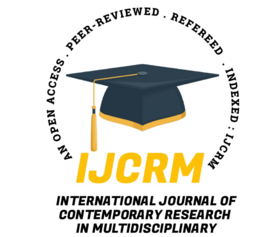International Journal of Contemporary Research In Multidisciplinary, 2025;4(4):119-122
Prevalence of Non-Alcoholic Fatty Liver Disease (NAFLD) based on Abdominal Ultrasound and Its Risk Factors in Nangarhar University Teaching Hospital
Author Name: Rahmatzai Nasseemullah; Hadi Naqeebullah; Hashimi Sayed Azizullah; Hadi Saifullah; Sherzai Aimal;
Paper Type: research paper
Article Information
Abstract:
BACKGROUND: Non-alcoholic fatty liver disease (NAFLD) is one of the major liver diseases that disrupts the functioning of the liver and is a dangerous condition that can be a direct cause of death. Because the prevalence and risk factors of NAFLD were not known at the Nangarhar University teaching Hospital, our aimed is to determine the prevalence of NAFLD based on abdominal ultrasound and its risk factors, including obesity, diabetes mellitus (DM), hypertension, age and hyperlipidemia in Nangarhar University Teaching Hospital.
METHOD: This is a cross-sectional study, which ran from 1/1/2023 to 30/7 /2023. In this study, all patients (men and women) who had NAFLD and those who had risk factors such as age, obesity, hypertension, diabetes mellitus, and blood lipid disorders such as hypertriglyceridemia and hypercholesterolemia were included. Our research started this way: when the patients were referred for abdominal ultrasound examination and their examination revealed a fatty liver with the presence of characteristic sonographic findings. The patients with a history of Alcohol drinking we’re not allowed to participate in the study. Our study used non-probability purposive sampling. Permission from the patients to participate in the study was first acquired, and the Trained Doctor then completed the questionnaire we created. The Teaching Hospital offers free abdominal ultrasonography examinations, blood tests (including blood lipid and blood sugar), and patient weight measurements. An abdominal ultrasonography machine, patient files, a Sphygmomanometer, blood lipids, and sugar levels were among the supplies needed to complete the study. SPSS and Excel are used to examine research data.
RESULT: 2,397 people—1,471 women and 926 men—referred for abdominal ultrasound exams at Nangarhar University Teaching Hospital's Radiology Department. hundreds of them had fatty livers. overall prevalence of NAFLD was 4.21%. NAFLD was more common in people over 40 (66%) and in people 40-20 (45.31%). Of the NAFLD patients, 35% had normal blood pressure and 63% had hypertension. 24(15%) of NAFLD patients were no obesity, while 84% of patients had obesity. Diabetics made up 43% of NAFL patients. Twenty percent of NAFLD patients had Hypercholesterolemia, and sixty percent of NAFL patients had hypertriglyceridemia. and Grade I fatty livers were present in every NAFLD patient. prevalence ratio of NAFLD was 2.83% in female and 1.33% in male
CONCLUSION: NAFLD is more common in women than men, and the incidence of NAFLD is also high in patients who had risk factors such as obesity, hypertension, and diabetes, and the population is over 40 years old.
Keywords:
Abdominal Ultrasound, Blood Lipids, DM, Gender, Hypertension, NAFLD, Obesity
How to Cite this Article:
Rahmatzai Nasseemullah,Hadi Naqeebullah,Hashimi Sayed Azizullah,Hadi Saifullah,Sherzai Aimal. Prevalence of Non-Alcoholic Fatty Liver Disease (NAFLD) based on Abdominal Ultrasound and Its Risk Factors in Nangarhar University Teaching Hospital. International Journal of Contemporary Research in Multidisciplinary. 2025: 4(4):119-122
Download PDF





